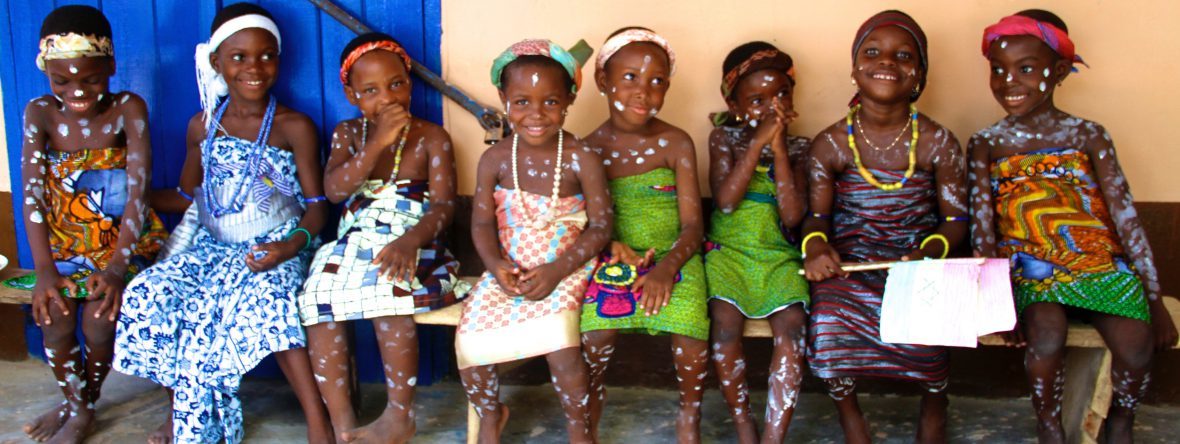When the American musician and composer Robert Levin first traveled to Kopeyia to study traditional Ghanaian culture with Godwin Agbeli in 1988, the 2,000 inhabitants of this rural farming village in Southeastern Ghana were facing steeply diminishing crop yields and escalating poverty, stemming from generations of illiteracy, a paucity of resources, and continued isolation from the outside world. Families lacked the means to send their children to the nearest elementary school, located some kilometers away. Meanwhile knowledge of health, nutrition and sustainable farming techniques was scarce.
Levin’s appreciation for Ghanaian culture and his observation of Kopeyia’s lack of educational opportunity and his love for the village’s children moved him to ask Godwin whether they could try to build a public school in Kopeyia. Together they offered their efforts to Kopeyia’s elders, if the elders decided they wanted to establish a school in their village. The elders assented, and Godwin organized Kopeyia to open its school on October 10, 1988, with 80 students, and 2 literate villagers, with community benches, under a thatched shade. Robert established the Kopeyia Ghana School Fund (KGSF) in the USA in 1989. The team’s first task was to build a permanent village primary school building. Within a few months, Kopeyia had successfully combined cement bought with $1,000 in KGSF-raised funds, with 10 acres of locally donated land, and the labor of the entire community to build the walls for its first 5-room school building. The village made due with a thatched roof on the new building for three years, until a permanent roof could be constructed. During that time, the students carried their desks and chairs to and from school every day, to prevent the wood from spoiling in the event of rain. In 1991 a permanent roof was built on the first building and construction of a second school building began.
Since 1988, KGSF has made the light of education possible for thousands of Kopeyia youths. The Kopeyia Bloomfield Local Authority School now offers pre-school through Junior High School (9th grade) curriculum. Thanks to years of incredibly generous donations from hundreds of American donors, most notably from author Ann M. Martin and her Foundation, the school’s physical plant now includes four permanent buildings, with 18 classrooms including a computer center, the Ann M. Martin Library, a science lab, staff common room, head teacher’s office, plus two permanent buildings built completely by the Kopeyia community for the Kindergarten and pre-school. There is a cafeteria, two water tanks, a soccer field, and a farming plot to practice agricultural science lessons. Extra-curricular activities include an incredible Cultural Troupe, a Girls Club whose members study health and nutrition and convey that knowledge throughout the school, Reading Club, sports teams in soccer, volleyball, track and field, and netball, and extra classes to prepare the oldest class for their standard national final exams.
In 1996, KGSF began offering scholarships to Kopeyia’s top ninth grade graduates to attend the region’s best high schools for grades 10-12. (There are still no public high schools or universities in Ghana….). Since that time, more than 250 Kopeyia residents have earned scholarships, and have graduated from high school and vocational school. Many of those have also continued their studies through the university level with KGSF scholarships.
Graduates of the Kopeyia Bloomfield Local Authority School now have an incredible variety of careers, and are based in many cities, towns, and villages around Ghana. Their occupations include: Director of a bio-medical lab, university professor, many teachers, some policemen, a car mechanic with his own shop in Accra, Ghana’s capital; a graphic designer with his own business in Accra, computer software engineers, journalist, nurse, investment advisor, accountants, musicians, pastors, caterers, seamstresses, hairdressers, and yes, farmers! Those who are doing well are now paying fees for the high school educations of their own younger brothers and sisters and for their own children.
The great challenge is for the Kopeyia School graduates to bring their businesses and careers back to the village, or as close to the village as they can. Wherever they are, Kopeyia graduates are productive citizens who live by the school’s motto, coined by the school’s first Headmaster, Frederick O.K. Mensah, “Brighten the corner where you are!”, and by the exhortation of the school’s co-founder Godwin Agbeli, from his school inauguration speech, “Whatever you do, do it well!”. Kopeyia School graduates keep their alma mater in mind, and are beginning to bring donations back for the Kopeyia School Management Committee to use to maintain the school’s physical compound as well as the extra-curricular activities, especially the Cultural Troupe. And the next collective goal of the Kopeyia community is to bring running water to the homes and farms and businesses in the village.


